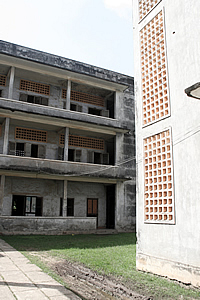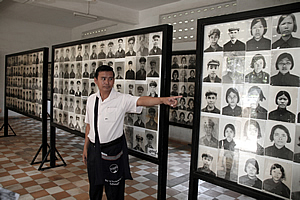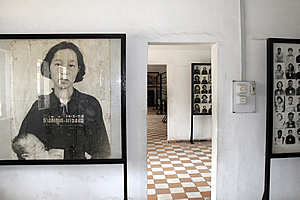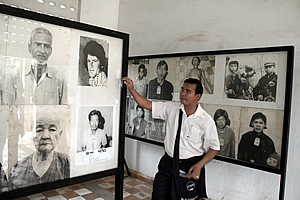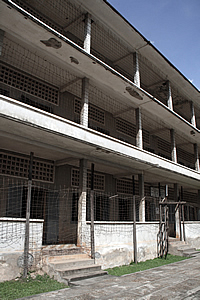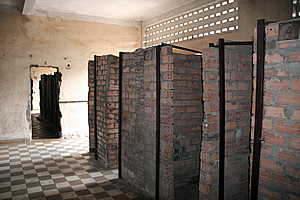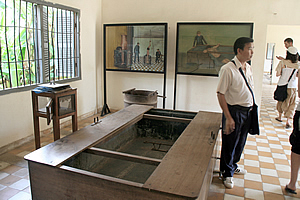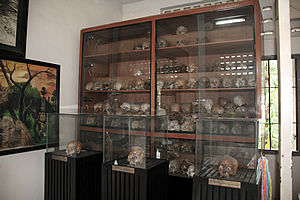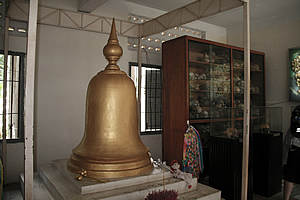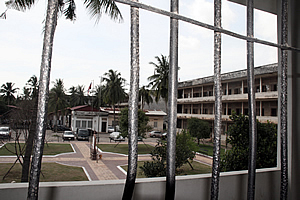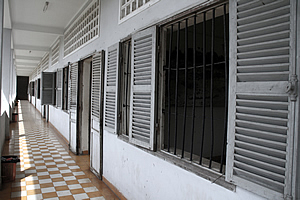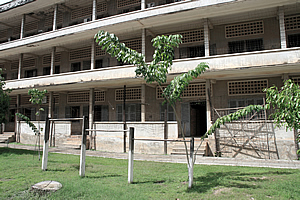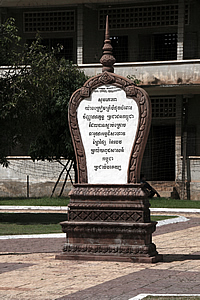--- Archive files ---
Home > Travels > Phnom Penh > 3 |
Ghosts of the Forgotten
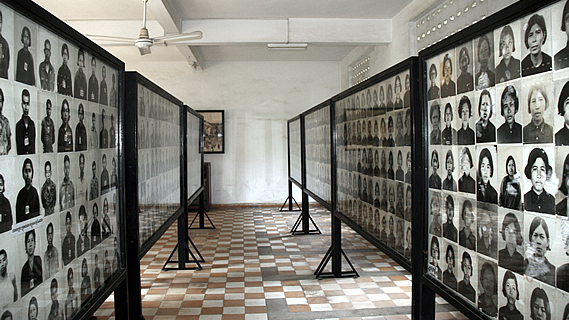
HAVING seen one block of classrooms in Tuol Sleng where prisoners had been tortured, I was wondering what would come next. Behind the high frame where people were executed by hanging, stood another derelict three storey classroom block. The paint had almost completely gone leaving the bare concrete exposed to the tropical elements.
Blocks of classrooms |
My tour guide Ponleak led us towards this block of classrooms, but not before pointing out the small security guard building back near the main entrance.
By day many tourists passed through here. By night the school was only occupied by a couple of security guards to keep any looters out. It was hard to imagine anyone wanting to break into here though. It was widely known this museum reeked of evil and was too haunted for anyone of any level of sanity to enter. People living in the surrounding streets were too scared to go outside at night. The guards who work here at night huddle together in the small building and regularly see black shadow apparitions in the complex. They often see the palm trees in the courtyard swaying uncontrollably even though the air may be completely still. I couldn’t imagine a worse possible place to work a night shift.
Ponleak tells the stories |
We entered the first of the classrooms on the ground floor. This one was bigger than the classrooms we had explored in the other block. The walls were freshly painted white but the floor was the same worn patchwork of white and poo brown tiles we had previously seen. There were two fans on the ceiling, but they weren’t operating even though it was stifling hot in here. Perhaps this was a cool day by Cambodian standards.
I had entered expecting to see another rusting bed frame in the middle of the room. Instead this classroom had rows large standing cork boards along its length covered with the photos of the people who had died here. Every prisoner had been photographed with a three digit numbered tag hanging from their necks. The ghostly black and white photos hung on the large boards all through two classrooms. The images of the emaciated faces and the sunken eyes haunted us as our guide explained the histories of some of them to us. The images were mostly of men, but included a lot of women, some carrying babies.
Mother and baby in the prison |
The photos had been attached to dossiers about each prisoner containing their confessions and any other documentation used as evidence against them. Unfortunately the photos got separated from the dossiers after the Vietnamese overthrew the prison in 1979 and 1980, so the people in most photos remain unknown to this day.
One board had the images of foreigners who had been unfortunate enough to have been in Cambodia at the time the revolution started. This included one Australian man, whose name was incorrectly shown. The incorrectly labelled man’s wife once took the harrowing trip here only to find that this was another man incorrectly labelled under the photograph. Her real husband remains missing to this day. There was also a New Zealander who had been captured sailing around the south of the country, brought here and executed.
Ponleak tells the stories of the captured foreigners |
We saw one photo of a group of men standing together in front of some palm trees. The end of the photo had been ripped off though. He had been fortunate in not having been taken here and had managed to seek exile in France. He was the son of King Shinouk and now the Cambodian king. I suppose his image had been removed as a means of respect for the king.
Once through the two classrooms of photos, we entered a similar room but this one did not have the standing boards of photos, but instead had some huge racks for torture. I imagined how they could have been used, with the victim’s arms and legs tied up in the chains at either end and pulled. Whether this was just to hold them in place, or to tear their limbs off, we’ll never know.
A sign reads:Ground Floor – Single cells made of brick. |
Once we had a look around the room. We went back outside and passed the next two classrooms which were covered up with wire netting to prevent access. Perhaps whatever was in there was too gruesome for the public to see. An eerie white sign above the classroom almost hidden from erosion and barbed wire outlined the use of this block.
We walked the short distance to the next block, sitting adjacent to the one we had just passed. We entered the access door to the first ground floor classroom. It was full of tiny very crude brick prisons haphazardly built in a very amateur fashion, resembling toilet cubicles. The cell bars were now missing, and the brick walls seemed to be very flimsy and easy to knock down. Some of these walls had been reinforced to prevent them from falling down.
The bricks were hollow and had been cemented in crudely by too much mortar which had dribbled down the sides of the bricks. These cells would have been most appalling conditions for the prisoners.
A crude doorway had been cut into the next classroom with a masonry saw. The following two classrooms contained similar prisons to the ones that I was currently in. Similar crude doorways went into the next two classrooms back towards the photo gallery.
Prison block |
We returned outside and walked further along to almost the end of the block before entering another classroom containing a few maps on the wall. These maps were all written in Khmer and French and had arrows showing the invasions led by Pol Pot. The room had cabinets full of torture weapons and more photos. There were large wooden racks where people had their limbs pulled.
The walls on the other side of the room contained paintings. One painting depicted a man being lowered upside down in a large vat of water where his head would be submerged when he relaxed. Therefore to stay alive he would have to pull himself up to keep his head out of the water. This would result in severe cramping and sleep deprivation until he would finally succumb to exhaustion and drown. Another painting showed a man immersed face down in a tank of water with his wrists tied to the side. Again he would have to hold himself up and stay awake until he would collapse from exhaustion and drown.
Torture room |
Ponleak explained the prisoners were tortured in many ways, including beatings, electric shocks, red hot metal instruments, hanging, and suffocation with plastic bags. They had their fingernails pulled out whilst having alcohol poured on their wounds. Many prisoners died from their torture. Proper executions were highly discouraged though as their confessions were needed. There was a medical unit of untrained doctors who would often bleed the prisoners to death.
During the interrogations, the confessions would include the names of people. These people were hunted down and where successfully found, brought in for interrogation.
Cabinet full of human skulls |
Finally we entered a room at the far end of the block. This room was a lot smaller than the others. Perhaps it had been a storage room. The room contained a large gold coated Buddhist bell along the middle of the back wall. There were a couple of cabinets containing about two thousand skulls of those killed here. In amongst the skulls were scattered some human thigh bones. It was very confronting. There were also about twelve stands evenly placed around the room. Each stand had a cubic glass casket on top of the stand each containing one skull looking towards the middle of the room. There was an inscription on each stand. These people would have perhaps been dignitaries.
Buddhist shrine in room of skulls |
The skulls had until 2002 been assembled as part of a famous map of Cambodia created from the two thousand skulls left here after the executions. The map had since been dismantled and the skulls left here. A large photo of the map was all that remained.
We left the storage room and returned to the large classroom with the maps and paintings. Ponleak told us in his monotone high voice that the tour of this school was over, but we were free to explore for another half an hour before we move onto the killing fields.
Bars |
I left the block and started to explore the classrooms in the far block which faced back over the courtyard. I was alone, which suddenly made me very uneasy feeling an invisible shadow nearby following me.
There was no barbed wire here, and we had access to the upper levels. The outdoor corridors and classroom windows had thick bars on them. From the corridor I could see across the large courtyard where I could see several small jackfruit trees with large fruit on them. The courtyard the derelict buildings surrounded still had play equipment with weeds overgrowing them. I could almost hear the echoes of the children playing there three decades ago in the early 1970s. These children would have a little older than me. It was hard to imagine that while I was innocently going to school a world away in the peaceful isles of New Zealand, the worst atrocities were going on here in this school.
Ghosts of the silent classrooms |
I was mistaken though. There were no children here, instead the echoes were coming from the lost shadowy apparitions of those who had been executed here and their bodies disposed of without a proper Buddhist burial. Here they were eternally trapped here in the hellish purgatory on Earth. Despite some attempted Buddhist rituals to release their souls to rest in peace, they were still here haunting this place.
I returned from the eerie classroom block where I met up with Eric (my tour leader) under one of the larger jackfruit trees. It had huge green irregular shaped fruit, one of which would have been about twenty kilograms. They can grow up to thirty kilograms being the biggest fruit in the world. In future whenever I would see a jackfruit tree, especially the one I would grow in my garden a couple of years later, I would be reminded of the atrocities that happened here and the evil that lingers in this school to this day.
Where the children once played |
I asked Eric how he has managed to desensitise himself from this after having lead so many tours through here. He told me that he hadn’t. He found it very confronting every single time he came here. Coming here the first time was a completely new experience, but coming here every few weeks and getting to know this place feeling the same evil presence here every time must be awful, certainly something to not look forward to each trip.
Ponleak would have to run this gruesome tour every single day for a tour group of people he had never met before, and would most likely never meet again. He has probably been doing this for years. I was not sure if he knew anyone who had been killed here. He would be in his mid-thirties, so he would have been a baby at the time. Perhaps some close relatives had died here, and maybe by coming here every day showing the people of free lands the atrocity that indelibly affected him so was his way of dealing with it.
Memorial |
The Cambodian people of his age and older still carried the deep emotional scars of the Pol Pot regime and the atrocities it brought. I had noticed the younger ones were a lot happier, but they had not been around back then. Each older person had to find their own way of dealing with the loss of relatives and friends in the most inhumane manner. I guessed this was how our tour guide Ponleak dealt with it.
I left Eric and walked towards a large stone memorial with an inscription in Khmer. In front of the memorial was a small golden urn full of incense sticks. There was a flagpole on either side, with the left pole flying a red and blue flag. The other pole didn’t have a flag on it. I didn’t understand the inscription, but no words would have done justice to this happy school turned to a dungeon at the centre of some of the worst atrocities in modern history and since left to eventually decay back into the dust of the earth.
Finally I stepped outside the barbed wire gate and joined the others at the van, to set off in discovery of more of Cambodia’s dark history. Everyone in the van was very quiet, having been haunted by the ghosts of the forgotten in Tuol Sleng.
<< Previous | Next >> |
|
||
About this Page
|
||
|
|
|
Where is Walkabout Jeff? |
|
|
|
|
What is happening in Walkabout Jeff's hometown?
|
|
|
|
|
Who is Walkabout Jeff?Any normal person's idea of going out involves going to the local pub for a drink with a few mates. Walkabout Jeff isn't normal.
|
|
|
|
|
